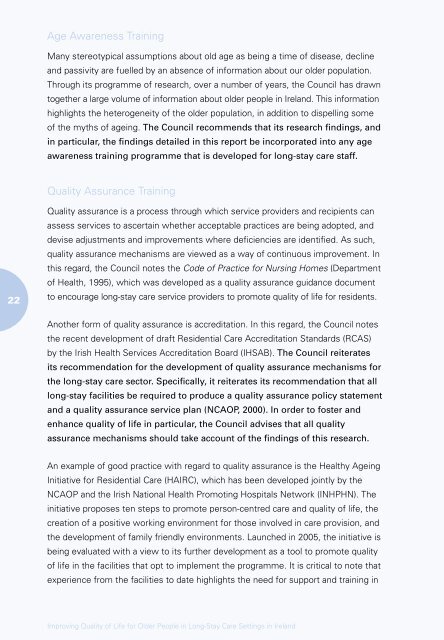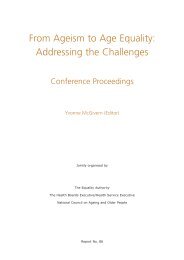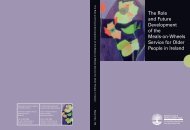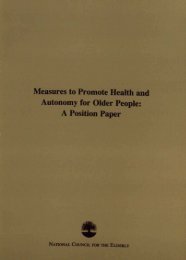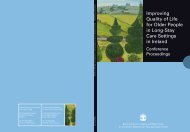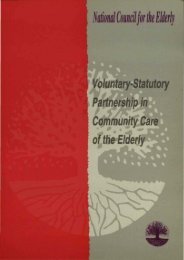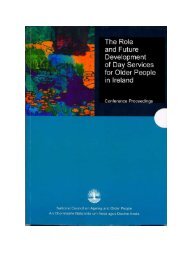Improving Quality of Life for Older People in Long-Stay Care ...
Improving Quality of Life for Older People in Long-Stay Care ...
Improving Quality of Life for Older People in Long-Stay Care ...
- No tags were found...
You also want an ePaper? Increase the reach of your titles
YUMPU automatically turns print PDFs into web optimized ePapers that Google loves.
Age Awareness Tra<strong>in</strong><strong>in</strong>gMany stereotypical assumptions about old age as be<strong>in</strong>g a time <strong>of</strong> disease, decl<strong>in</strong>eand passivity are fuelled by an absence <strong>of</strong> <strong>in</strong><strong>for</strong>mation about our older population.Through its programme <strong>of</strong> research, over a number <strong>of</strong> years, the Council has drawntogether a large volume <strong>of</strong> <strong>in</strong><strong>for</strong>mation about older people <strong>in</strong> Ireland. This <strong>in</strong><strong>for</strong>mationhighlights the heterogeneity <strong>of</strong> the older population, <strong>in</strong> addition to dispell<strong>in</strong>g some<strong>of</strong> the myths <strong>of</strong> age<strong>in</strong>g. The Council recommends that its research f<strong>in</strong>d<strong>in</strong>gs, and<strong>in</strong> particular, the f<strong>in</strong>d<strong>in</strong>gs detailed <strong>in</strong> this report be <strong>in</strong>corporated <strong>in</strong>to any ageawareness tra<strong>in</strong><strong>in</strong>g programme that is developed <strong>for</strong> long-stay care staff.<strong>Quality</strong> Assurance Tra<strong>in</strong><strong>in</strong>g22<strong>Quality</strong> assurance is a process through which service providers and recipients canassess services to ascerta<strong>in</strong> whether acceptable practices are be<strong>in</strong>g adopted, anddevise adjustments and improvements where deficiencies are identified. As such,quality assurance mechanisms are viewed as a way <strong>of</strong> cont<strong>in</strong>uous improvement. Inthis regard, the Council notes the Code <strong>of</strong> Practice <strong>for</strong> Nurs<strong>in</strong>g Homes (Department<strong>of</strong> Health, 1995), which was developed as a quality assurance guidance documentto encourage long-stay care service providers to promote quality <strong>of</strong> life <strong>for</strong> residents.Another <strong>for</strong>m <strong>of</strong> quality assurance is accreditation. In this regard, the Council notesthe recent development <strong>of</strong> draft Residential <strong>Care</strong> Accreditation Standards (RCAS)by the Irish Health Services Accreditation Board (IHSAB). The Council reiteratesits recommendation <strong>for</strong> the development <strong>of</strong> quality assurance mechanisms <strong>for</strong>the long-stay care sector. Specifically, it reiterates its recommendation that alllong-stay facilities be required to produce a quality assurance policy statementand a quality assurance service plan (NCAOP, 2000). In order to foster andenhance quality <strong>of</strong> life <strong>in</strong> particular, the Council advises that all qualityassurance mechanisms should take account <strong>of</strong> the f<strong>in</strong>d<strong>in</strong>gs <strong>of</strong> this research.An example <strong>of</strong> good practice with regard to quality assurance is the Healthy Age<strong>in</strong>gInitiative <strong>for</strong> Residential <strong>Care</strong> (HAIRC), which has been developed jo<strong>in</strong>tly by theNCAOP and the Irish National Health Promot<strong>in</strong>g Hospitals Network (INHPHN). The<strong>in</strong>itiative proposes ten steps to promote person-centred care and quality <strong>of</strong> life, thecreation <strong>of</strong> a positive work<strong>in</strong>g environment <strong>for</strong> those <strong>in</strong>volved <strong>in</strong> care provision, andthe development <strong>of</strong> family friendly environments. Launched <strong>in</strong> 2005, the <strong>in</strong>itiative isbe<strong>in</strong>g evaluated with a view to its further development as a tool to promote quality<strong>of</strong> life <strong>in</strong> the facilities that opt to implement the programme. It is critical to note thatexperience from the facilities to date highlights the need <strong>for</strong> support and tra<strong>in</strong><strong>in</strong>g <strong>in</strong><strong>Improv<strong>in</strong>g</strong> <strong>Quality</strong> <strong>of</strong> <strong>Life</strong> <strong>for</strong> <strong>Older</strong> <strong>People</strong> <strong>in</strong> <strong>Long</strong>-<strong>Stay</strong> <strong>Care</strong> Sett<strong>in</strong>gs <strong>in</strong> Ireland


